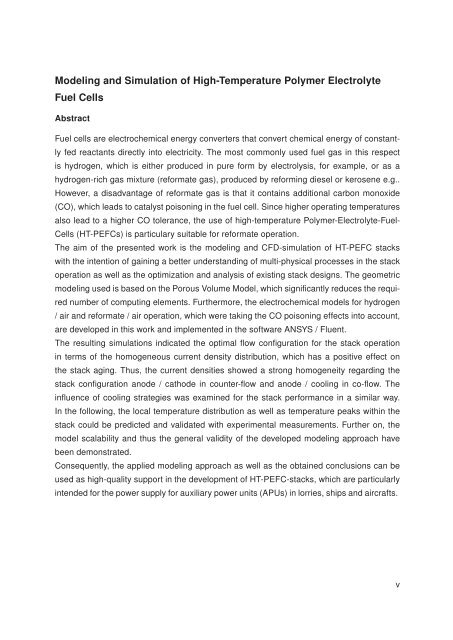Modellierung und Simulation von Hochtemperatur ... - JuSER
Modellierung und Simulation von Hochtemperatur ... - JuSER
Modellierung und Simulation von Hochtemperatur ... - JuSER
Sie wollen auch ein ePaper? Erhöhen Sie die Reichweite Ihrer Titel.
YUMPU macht aus Druck-PDFs automatisch weboptimierte ePaper, die Google liebt.
Modeling and <strong>Simulation</strong> of High-Temperature Polymer ElectrolyteFuel CellsAbstractFuel cells are electrochemical energy converters that convert chemical energy of constantlyfed reactants directly into electricity. The most commonly used fuel gas in this respectis hydrogen, which is either produced in pure form by electrolysis, for example, or as ahydrogen-rich gas mixture (reformate gas), produced by reforming diesel or kerosene e.g..However, a disadvantage of reformate gas is that it contains additional carbon monoxide(CO), which leads to catalyst poisoning in the fuel cell. Since higher operating temperaturesalso lead to a higher CO tolerance, the use of high-temperature Polymer-Electrolyte-Fuel-Cells (HT-PEFCs) is particulary suitable for reformate operation.The aim of the presented work is the modeling and CFD-simulation of HT-PEFC stackswith the intention of gaining a better <strong>und</strong>erstanding of multi-physical processes in the stackoperation as well as the optimization and analysis of existing stack designs. The geometricmodeling used is based on the Porous Volume Model, which significantly reduces the requirednumber of computing elements. Furthermore, the electrochemical models for hydrogen/ air and reformate / air operation, which were taking the CO poisoning effects into account,are developed in this work and implemented in the software ANSYS / Fluent.The resulting simulations indicated the optimal flow configuration for the stack operationin terms of the homogeneous current density distribution, which has a positive effect onthe stack aging. Thus, the current densities showed a strong homogeneity regarding thestack configuration anode / cathode in counter-flow and anode / cooling in co-flow. Theinfluence of cooling strategies was examined for the stack performance in a similar way.In the following, the local temperature distribution as well as temperature peaks within thestack could be predicted and validated with experimental measurements. Further on, themodel scalability and thus the general validity of the developed modeling approach havebeen demonstrated.Consequently, the applied modeling approach as well as the obtained conclusions can beused as high-quality support in the development of HT-PEFC-stacks, which are particularlyintended for the power supply for auxiliary power units (APUs) in lorries, ships and aircrafts.v
















